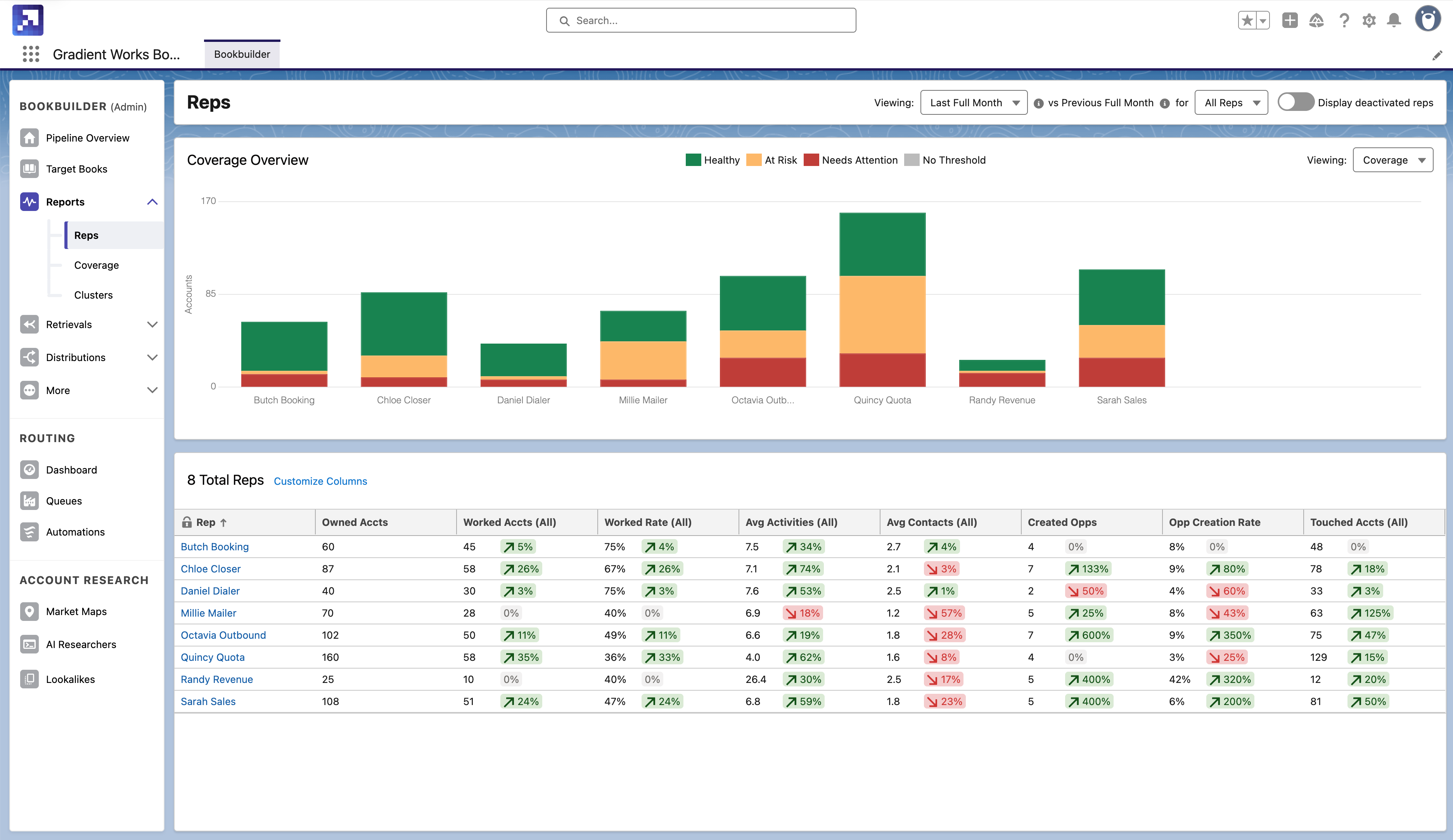We held our first-ever customer summit last week, and thanks to all our amazing customers the event was a huge success. We all learned a lot about how sales teams are using dynamic books.
Sessions included a discussion of the strategy behind moving to dynamic books and the kinds of changes CROs have seen on their teams. There was an ops-focused session all about implementing dynamic books. We also had a hands-on workshop for sales managers on how they can coach reps on better account coverage.
Here are some of the stories from the summit, straight from the mouths of our customers.
Reps are more focused with a more balanced approach
"I was talking to an AE who said, 'Dynamic books is the best thing that I've seen in sales. It gives me focus.' It's music to my ears to hear this from our reps."
-Emilia Meldrum-Taylor, CRO at Quantive
"EMEA account executives were touching 3-5x more accounts to deliver revenue. In the meantime, in America, we noticed that reps were spending time on a very small amount of accounts with a high level of intensity, to close the same amount of revenue. So obviously there's a massive discrepancy in efficiency.
What keeps me up at night is coverage. So I was seeing that 3-5x 'spray and pray' approach in EMEA versus the US approach where they're going really deep into accounts and maybe not delivering on the velocity, and I'm expecting to get to where we want to get from a revenue perspective, clearly there were a lot of challenges that were not addressed properly with our previous setup.
We are trying to create a more balanced approach when it comes to sources of pipeline between marketing MQLs, ABM, as well as outbounding.
We've only been using dynamic books for less than a quarter, but we are already starting to see the value add. To hear from the direct beneficiary consumer of the product, which is my reps, that this product is giving them focus? I am very happy."
Flexible account coverage allows quick adjustments
"With dynamic books, we can quickly react to what's going on in the market and refocus our energy on industries where deals are still moving well."
- Kevin McKeown, CRO at Beekeeper
"I remember when I started here, the BDRs all had over 1000 accounts. Basically, they were getting imbalanced working an account and then getting another one, and they just never were getting rid of any of the accounts they were collecting. It was like a bad shoe collection.
Account coverage is how many accounts can they work in a rolling 30-day window. You're going to quickly find that, despite some with superhuman powers, most AEs and BDRs can effectively work roughly 70 to 90 accounts effectively, with meaningful activity. So looking at that, you reverse engineer to get the right book size. For AEs, it's 15 to 20 active opportunities, and a prospecting set of 50 to 60 accounts that they can keep active. For BDRs, you're gonna go more aggressive, so they're gonna need about 100 accounts because they'll be doing activity all day long. And reps that are working large enterprise accounts, they're having to multi-thread across lots of different personas and titles, so their book is going to shrink probably down to 20 to 25 accounts. So you'll adapt that size, based on the types of accounts are calling into, their seniority, how many active opportunities they're working - those are the factors that I start off with.
But zooming back to the bigger picture of the strategy, we use intent data to look at the full set of accounts that are in the purchase stage, the final stage of intent, the decision stage, and then the consideration phase. And it gives you have a sense of how much TAM you have in each stage, then you look at your headcount and you can figure out the right allocation of purchase accounts and decision accounts per BDR, per AE and so on. You can map out what the logical book should look like.
Having it laid out and well defined but flexible at the same time, means we can adapt to market conditions or discover a new TAM we didn't know we previously were selling into."
Moving from pods to pools has improved BDR opportunity creation
"In March, we've had more opportunities created per BDR than we've ever had before."
-Andrew de Geofoy, SVP Global Revenue Platform at Quantive
"When we implemented dynamic books, we moved away from a pod model into more of a pool model. We said BDRs are still going to be the primary ones getting inbound leads. But if a lead comes in that's related to an account that's already owned by an AE, it goes directly to the AE and they are expected to work that lead themselves. And any inbound leads that are not associated with an owned account go to the BDRs to work it.
BDRs have their own book of business at about 150 accounts, and they also are managing inbound leads. They'll typically start with inbound leads, and then work on outbound prospecting after they've exhausted that pool. But now, we've changed the model to where when they work a lead, they actually take the account and create an opportunity and get that to the stage one qualification. Then when it's ready to be handed off to an AE, they click a button and then it automatically routes it to an AE who has available capacity in their book of business. And that's been working really well so far.
These changes to lead routing and the rules of engagement around how BDR and AEs work together was largely precipitated by dynamic books."
Pipeline is more evenly distributed and rules of engagement are simpler
"Now we have more even distribution of pipeline across the team and more even quota attainment, and it's been really well received by the sellers."
-Britton Quinn, Senior Director Revenue Operations, Center
"We really wanted to focus on simplifying, especially the structure of our sales org. Prior to this year, we had an employee segmentation base - small business, mid-market and up-market, and then we were also geo-based. And we wanted to essentially get rid of both of those segmentation criteria. So with a focus on starting simple, we essentially have one target book for the SDRs, and then we have three target books for the AES, which is divided by which role they're in.
Part of the reason behind that was we wanted to do away with a lot of rules of engagement distractions and disputes. So the dynamic books approach is really helpful there."
And lots more about dynamic books...
You can now watch all of the sessions on demand. Just enter your email below to access the videos and other resources from the summit.
Watch the summit sessions on demand
You can read more about dynamic books here.




